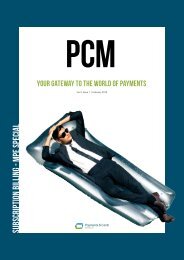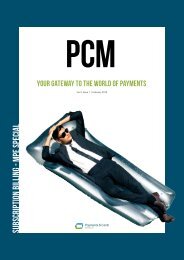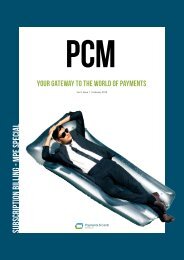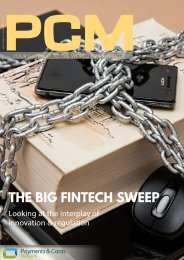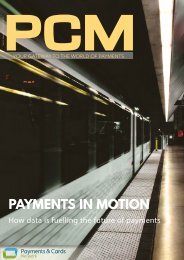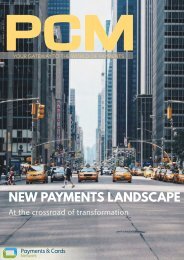PCM Vol.2 - Issue 6
You also want an ePaper? Increase the reach of your titles
YUMPU automatically turns print PDFs into web optimized ePapers that Google loves.
Thought Leaders Corner<br />
Fighting fraud with Bayesian analytics<br />
Effective fraud detection has many forms,<br />
from traditional rules-based approaches to<br />
sophisticated analytical models and machine<br />
learning.<br />
out from the crowd in its machine learning<br />
capabilities – the system can learn rapidly as<br />
frauds are tagged, constantly learning and selfcalibrating<br />
as fraud trends change. This means<br />
that fraud teams know that they are in the best<br />
possible position to identify and stop fraud when<br />
it happens.<br />
Within the industry, the most widely used<br />
analytical approach is to build Neural<br />
Network models using historic<br />
consortium data to build up a<br />
set of patterns to later use in<br />
detection of live card fraud.<br />
This approach has been used<br />
for many years with varying<br />
success. However, recently<br />
new approaches have become<br />
increasingly popular and have<br />
begun to overtake the results<br />
being achieved with traditional<br />
modelling techniques.<br />
NCR has pioneered a modern<br />
approach of fraud analytics,<br />
choosing to base its models<br />
on a more flexible Bayesian<br />
analytical technique. This<br />
methodology enables fraud<br />
teams to build models faster<br />
than it is traditionally possible,<br />
while achieving extremely<br />
good detection rates at low<br />
false positives.<br />
About NCR<br />
easier.<br />
The models form parts of the<br />
Fractals Adaptive Classification<br />
Engine, which provides automated, intelligent<br />
fraud detection using a combination of Bayesian<br />
statistical analysis and proprietary inference<br />
techniques. By applying mathematical models to<br />
each incoming transaction, the system identifies<br />
suspicious activity, calculates a probability-based<br />
fraud score that indicates the likelihood of fraud<br />
and then triggers an action.<br />
NCR Corporation (NYSE: NCR) is the global<br />
leader in consumer transaction technologies,<br />
turning everyday interactions with<br />
businesses into exceptional experiences.<br />
With its software, hardware, and portfolio of<br />
services, NCR enables more than 550 million<br />
transactions daily across retail, financial,<br />
travel, hospitality, telecom and technology,<br />
and small business. NCR solutions run the<br />
everyday transactions that make your life<br />
Unlike a Neural Network, which is nothing more<br />
than a “black box” that produces a score,<br />
Bayesian models produce scores that<br />
come with a clear set of reasons<br />
and probabilities. This “white box”<br />
approach gives the end user much<br />
more granular information to work<br />
with when assessing a transaction<br />
or speaking with a customer and, as<br />
we know, more information means<br />
better customer service - the key to<br />
successful fraud operations.<br />
Based on the risk score, pre-defined<br />
actions are triggered and the<br />
transactions are approved, rejected<br />
or referred. Custom rules can then<br />
be set for referred transactions. If<br />
an unusually large transaction is<br />
detected for a customer profile, the<br />
bank can inform the customer via<br />
SMS or e-mail about the suspicious<br />
transaction and get confirmation<br />
that the payment is authorized.<br />
Comparative tests have shown that<br />
the Bayesian models outperform<br />
industry standard solutions<br />
in detection rates and cause<br />
significantly fewer false positives. Enhanced<br />
with self-learning functions such models that<br />
can automatically adjust to new fraud scenarios.<br />
Fractals scores transactions in real time and can<br />
decline a transaction during the authorization<br />
request.<br />
The future of fraud<br />
The model is initially set and tuned using financial<br />
institution’s recent historical data and fraud tags<br />
so that it can identify the unique fraud patterns<br />
facing each unique organisation. The result is<br />
a bespoke and highly accurate fraud detection<br />
model that can be set up in just a few short<br />
weeks.<br />
Each model in the Adaptive Classification Engine<br />
is based on a series of mathematical algorithms<br />
that are targeted to identify specific fraud<br />
patterns or irregularities in the account’s holder<br />
behaviour. However, the system really stands<br />
The truth is that fraud isn’t going to disappear any<br />
time soon – criminals have got too much to lose.<br />
There will always be new breaches or techniques<br />
to get past even the strongest security and fraud<br />
systems. And, unfortunately, there is no solution<br />
which is the answer to every problem.<br />
However, a fraud system that can assess a<br />
transaction in real time, based on a comprehensive<br />
understanding of customers’ historic behaviour<br />
and intelligent analysis compared to the latest<br />
fraud trends, will arm your fraud team to stop<br />
the highest possible levels of fraud.<br />
005





